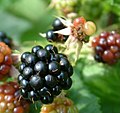Collective fruit
Collecting fruits are characterized by a coalescence of individual fruits (part fruits, fruits, Karpidien), all of the carpels of a single flower in stem.
They arise from flowers with apocarpic (that is, from several non-fused carpels (carpels) consisting of) Gynoeceen . There are the following types of collective crops:
- Collective achene fruit (Achenecetum): e.g. B. Strawberries , rose hips , lotus flowers ( Nelumbo spp.) - single fruit is an achene . Is also referred to somewhat imprecisely as a common nut fruit .
- Samara collecting fruit (Samaracetum): tulip trees ( Liriodendron spp.) - single fruit is a wingnut (Samara)
- Collective stone fruit (Drupecetum): e.g. B. Blackberry , Raspberry - Single fruit is a stone fruit
- Collective berries (baccacetum): e.g. B. Annona species, pokeweed - single fruit is a berry
- Foliage fruit and apple fruit (Follicetum): e.g. B. apple , pear , quince , hawthorn - single fruit is a follicle fruit
With fruits such as strawberries, but also apples, pears, etc., there is another special feature that the pulp itself did not arise from the ovary , but largely from the flower base . So it can also be called a dummy fruit .
Fruits that arise from the intergrowth of individual fruits of several flowers of an inflorescence are known today as a fruit association. A previously common term was the closed fruit cluster .
gallery
literature
- Michael G. Simpson: Plant Systematics. Academic Press, 2006, ISBN 978-0-12-644460-5 , p. 386.
- Reinhard Lieberei, Christoph Reisdorff: Crop science. Founded by Wolfgang Franke . 7th completely revised and expanded edition. Thieme-Verlag, Stuttgart et al. 2007, ISBN 978-3-13-530407-6 , pp. 39-45.
- Werner Rauh : Morphology of useful plants. 2nd edition, Quelle & Meyer-Verlag, Heidelberg 1950, p. 105 ff.




